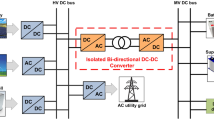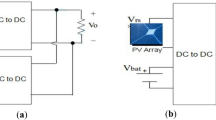Abstract
The usage of distributed resources of energy like solar PV as an alternative to conventional electric power system is gaining immense popularity in the recent days. The integration of low voltage PV to the grid or load requires implementation of an efficient DC–DC converter of high voltage gain. Hence, an Interleaved Luo converter with higher voltage gain ability that combines the benefits of both switched capacitor and interleaved topologies is employed in this article. The infusion of the interleaving approach to the Luo converter minimizes the effects of output voltage ripples and input current ripples. The selection of a suitable controller is extremely mandatory for enhancing the operation of the interleaved Luo converter by aiding the efficient minimization of peak overshoot and settling time. A Cascaded Fuzzy Logic Controller (CFLC) that overcomes the drawbacks of conventional converters is adopted in this research work to significantly heighten the working of the Interleaved Luo converter. The comparative evaluation of CFLC with Proportional Integral controller and Fuzzy Logic Controller is also performed. The efficiency of the Interleaved Luo converter with CFLC is determined through MATLAB simulation. The Interleaved Luo converter operates with an impressive efficiency of 98.6%.































Similar content being viewed by others
References
Bhaskar MS, Almakhles DJ, Padmanaban S, Blaabjerg F, Subramaniam U, Ionel DM (2020) Analysis and investigation of hybrid DC–DC non-isolated and non-inverting Nx interleaved multilevel boost converter (Nx-IMBC) for high voltage step-up applications: hardware implementation. IEEE Access 8:87309–87328
Qazi A, Hussain F, Rahim NABD, Hardaker G, Alghazzawi D, Shaban K, Haruna K (2019) Towards sustainable energy: a systematic review of renewable energy sources, technologies, and public opinions. IEEE Access 7:63837–63851
Lotfi F, Hussain A, Kerrouche A, Ieracitano C, Ahmad J, Mahmud M (2020) A highly-efficient fuzzy-based controller with high reduction inputs and membership functions for a grid-connected photovoltaic system. IEEE Access 8:163225–163237
Junfeng L, Jialei Wu, Qiu J, Zeng J (2019) Switched Z-source/quasi-Z-source DC–DC converters with reduced passive components for photovoltaic systems. IEEE Access 7:40893–40903
Pires VF, Cordeiro A, Foito D, Silva JFA (2021) Dual output and high voltage gain DC–DC converter for PV and fuel cell generators connected to DC bipolar microgrids. IEEE Access 9:157124–157133
Rajasekaran R, Rani PU (2021) Bidirectional DC–DC converter for microgrid in energy management system. Int J Electron 108(2):322–343
Bao D, Kumar A, Pan X, Xiong X, Beig AR, Singh SK (2021) Switched inductor double switch high gain DC–DC converter for renewable applications. IEEE Access 9:14259–14270
Moumita D, Pal M, Agarwal V (2019) Novel high gain, high efficiency DC–DC converter suitable for solar PV module integration with three-phase grid tied inverters. IEEE J Photovolt 9(2):528–537
Niraj R, Banerjee S (2020) Development of an improved input-parallel output-series buck-boost converter and its closed-loop control. IEEE Trans Industr Electron 67(8):6428–6438
Ahmed D, Holliday D, Ahmed S, Massoud AM, Williams BW (2014) A Single-stage three-phase inverter based on Cuk converters for PV applications. IEEE J Emerg Sel Top Power Electron 2(4):797–807
de Morais JCDS, de Morais JLDS, Gules R (2019) Photovoltaic AC module based on a Cuk converter with a switched-inductor structure. IEEE Trans Ind Electron 66(5):3881–3890
Tey KS, Mekhilef S, Seyedmahmoudian M, Horan B, Oo AT, Stojcevski A (2018) Improved differential evolution-based MPPT algorithm using SEPIC for PV systems under partial shading conditions and load variation. IEEE Trans Ind Inform 14(10):4322–4333. https://doi.org/10.1109/TII.2018.2793210
Kumaran N, Ghosh S, Siwakoti Y, Long T (2019) A new DC–DC converter for photovoltaic systems: coupled-inductors combined Cuk-SEPIC converter. IEEE Trans Energy Convers 34(1):191–201
Saravanan S, Usha Rani P, Thakre MP (2022) Evaluation and improvement of a transformerless high-efficiency DC–DC converter for renewable energy applications employing a fuzzy logic controller. MAPAN 37(2):291–310. https://doi.org/10.1007/s12647-021-00530-5
Rani PU, Saravanan S (2017) Simulation and modeling of SEPIC converter with high static gain for renewable application. In: Asian conference on energy, power and transportation electrification (ACEPT), pp 1–6. https://doi.org/10.1109/ACEPT.2017.8168573
Rajan K, Singh B (2016) BLDC motor-driven solar PV array-fed water pumping system employing zeta converter. IEEE Trans Ind Appl 52(3):2315–2322
Bhim S, Kushwaha R (2021) Power factor preregulation in interleaved Luo converter-fed electric vehicle battery charger. IEEE Trans Ind Appl 57(3):2870–2882
Khorramabadi SS, Bakhshai A (2015) Critic-based self-tuning PI structure for active and reactive power control of VSCs in microgrid systems. IEEE Trans Smart Grid 6(1):92–103. https://doi.org/10.1109/TSG.2014.2354651
Alturki FA, Omotoso HO, Al-Shamma’a AA, Farh HM, Alsharabi K (2020) Novel manta rays foraging optimization algorithm based optimal control for grid-connected PV energy system. IEEE Access 8:187276–187290
Ali MS, Wang L, Alquhayz H, Rehman OU, Chen G (2021) Performance improvement of three-phase boost power factor correction rectifier through combined parameters optimization of proportional-integral and repetitive controller. IEEE Access 9:58893–58909. https://doi.org/10.1109/ACCESS.2021.3073004
Ahmed KY, Yahaya NZB, Asirvadam VS, Saad N, Kannan R, Ibrahim O (2018) Development of power electronic distribution transformer based on adaptive PI controller. IEEE Access 6:44970–44980. https://doi.org/10.1109/ACCESS.2018.2861420
Vanchinathan K, Valluvan KTR, Gnanavel C, Gokul C, Albert JR (2021) An improved incipient whale optimization algorithm based robust fault detection and diagnosis for sensorless brushless DC motor drive under external disturbances. Int Trans Electr Energy Syst 31(12):13251
Vanchinathan K, Valluvan KR, Gnanavel C, Gokul C (2021) Design methodology and experimental verification of intelligent speed controllers for sensorless permanent magnet brushless DC motor: intelligent speed controllers for electric motor. Int Trans Electr Energy Syst 31(9):12991
Chandrasekaran G, Karthikeyan PR, Kumar NS, Kumarasamy V (2021) Test scheduling of system-on-chip using dragonfly and ant lion optimization algorithms. J Intell Fuzzy Syst 40(3):4905–4917
Ali M, Tariq M, Lodi KA, Chakrabortty RK, Ryan MJ, Alamri A, Bharatiraja C (2021) Robust ANN-based control of modified PUC-5 inverter for solar PV applications. IEEE Trans Ind Appl 57(4):3863–3876
Yung KY, Beh CM, Sarimuthu CR (2021) Fuzzy logic controller-based synchronverter in grid-connected solar power system with adaptive damping factor. Chin J Electr Eng 7(2):37–49
Ranjay S, Bansal RC (2019) Optimization of an autonomous hybrid renewable energy system using reformed electric system cascade analysis. IEEE Trans Industr Inf 15(1):399–409
Bose BK (2017) Artificial intelligence techniques in smart grid and renewable energy systems—some example applications. Proc IEEE 105(11):2262–2273
Yang S, Li S, Lin Bo, Xingang Fu, Ramezani M, Jaithwa I (2017) Artificial neural network for control and grid integration of residential solar photovoltaic systems. IEEE Trans Sustain Energy 8(4):1484–1495
Khan MNH, Forouzesh M, Siwakoti YP, Li L, Kerekes T, Blaabjerg F (2020) Transformerless inverter topologies for single-phase photovoltaic systems: a comparative review. IEEE J Emerg Sel Top Power Electron 8(1):805–835
Mojtaba F, Shen Y, Yari K, Siwakoti YP, Blaabjerg F (2018) High-efficiency high step-up DC–DC converter with dual coupled inductors for grid-connected photovoltaic systems. IEEE Trans Power Electron 33(7):5967–5982
Muttath MH, Baburaj P (2015) Interleaved Luo converter for the residential PV grid connected systems. In: 10th Asian control conference (ASCC), IEEE. pp 1–6
Alganidi A, Kumar A (2019) PI controller tuning & stability study of the flyback converter with an energy regenerative snubber. In: IEEE Canadian conference of electrical and computer engineering (CCECE). pp 1–4
Kunjittipong N, Kongkanjana K, Khwan-on S (2020) Comparison of fuzzy controller and PI controller for a high step-up singleswitch boost converter. In: 3rd International conference on power and energy applications (ICPEA), IEEE. pp 94–98
Sung-Kwun Oh, Kim W-D, Pedrycz W (2012) Design of optimized cascade fuzzy controller based on differential evolution: Simulation studies and practical insights. Eng Appl Artif Intell 25(3):520–532
Author information
Authors and Affiliations
Corresponding author
Additional information
Publisher's Note
Springer Nature remains neutral with regard to jurisdictional claims in published maps and institutional affiliations.
Rights and permissions
Springer Nature or its licensor (e.g. a society or other partner) holds exclusive rights to this article under a publishing agreement with the author(s) or other rightsholder(s); author self-archiving of the accepted manuscript version of this article is solely governed by the terms of such publishing agreement and applicable law.
About this article
Cite this article
Saravanan, S., Usha Rani, P. A Novel High Gain Interleaved Luo Dc–Dc Converter with Cascaded Fuzzy Logic Controller for PV System Application. J. Electr. Eng. Technol. 18, 925–940 (2023). https://doi.org/10.1007/s42835-022-01279-w
Received:
Revised:
Accepted:
Published:
Issue Date:
DOI: https://doi.org/10.1007/s42835-022-01279-w




